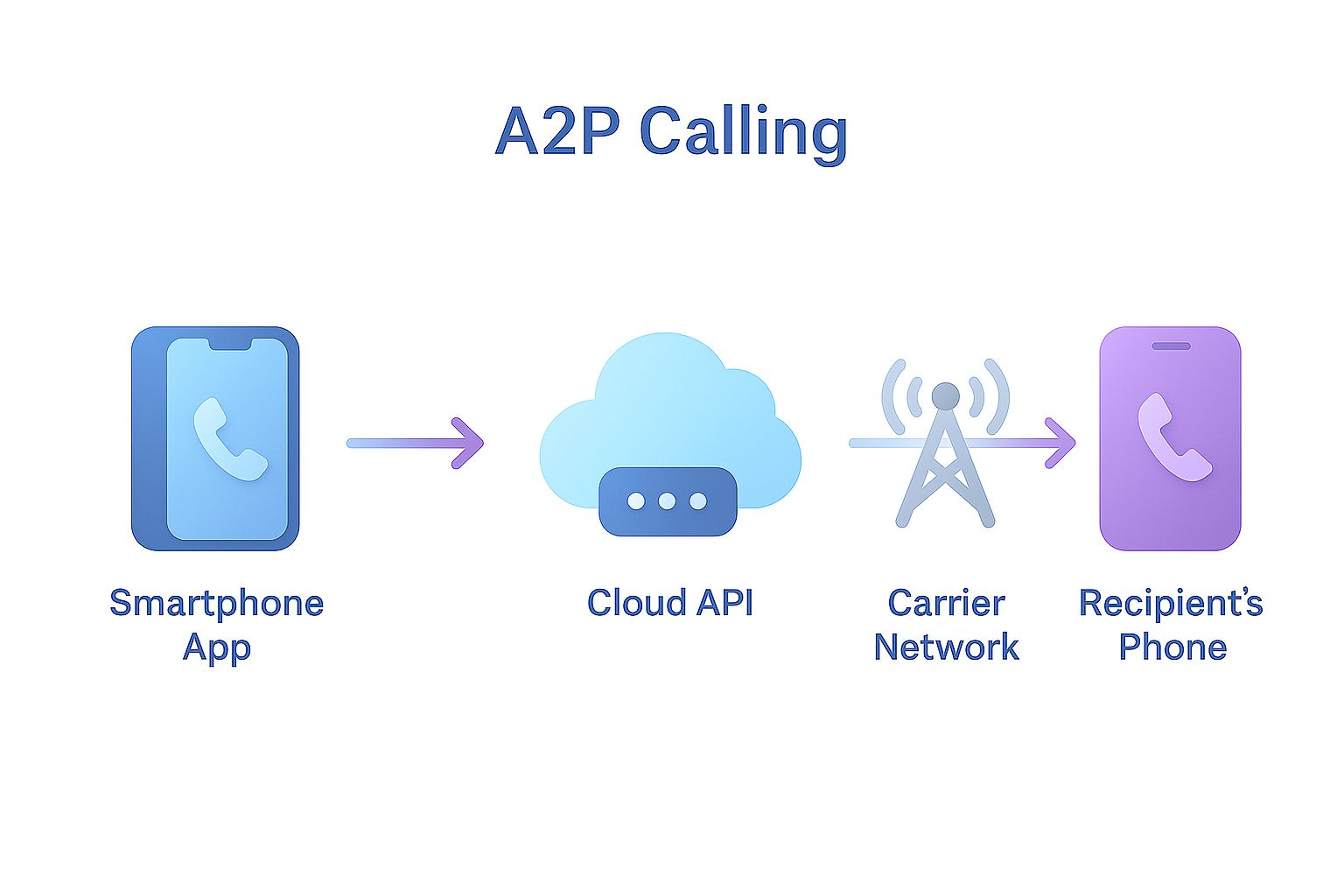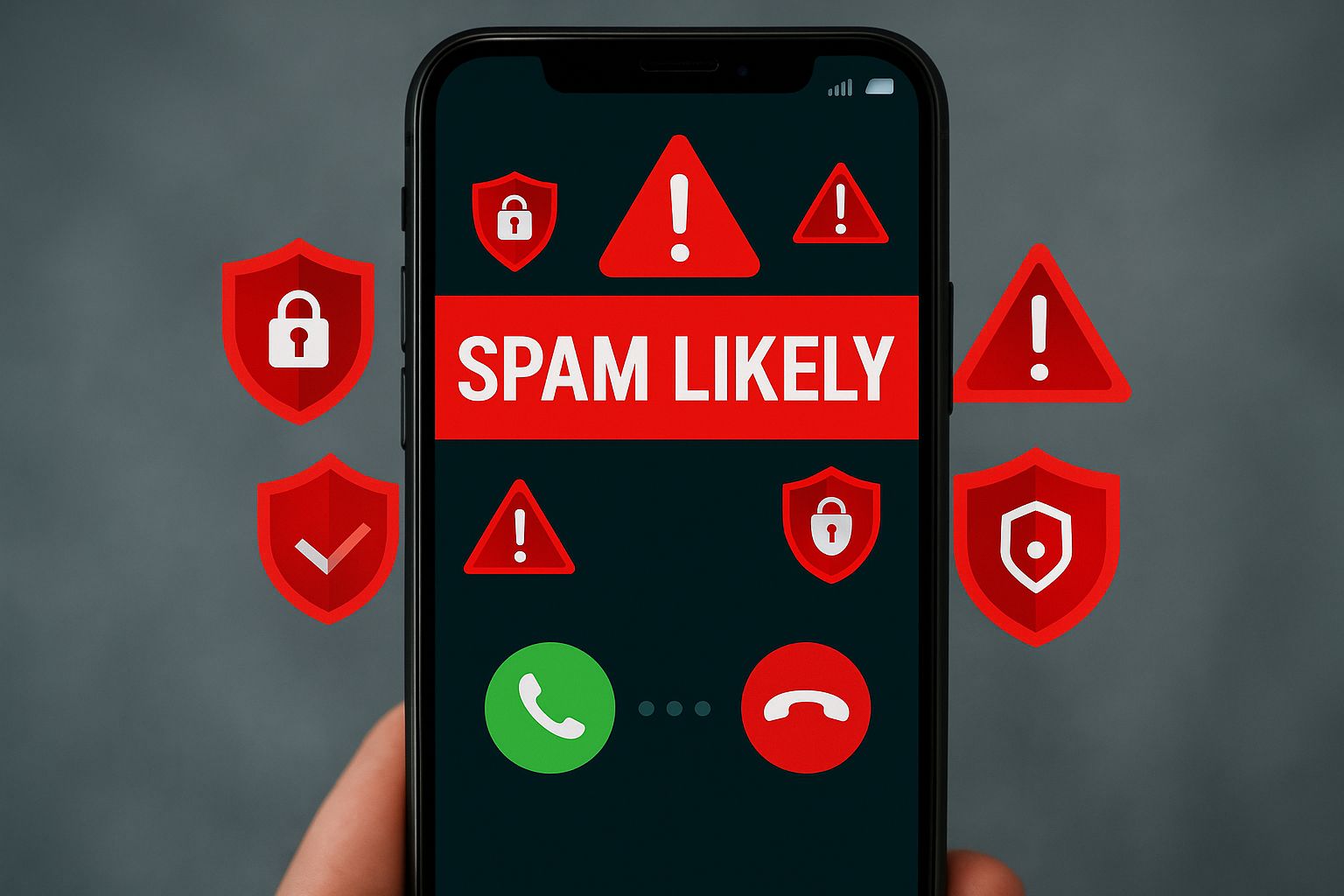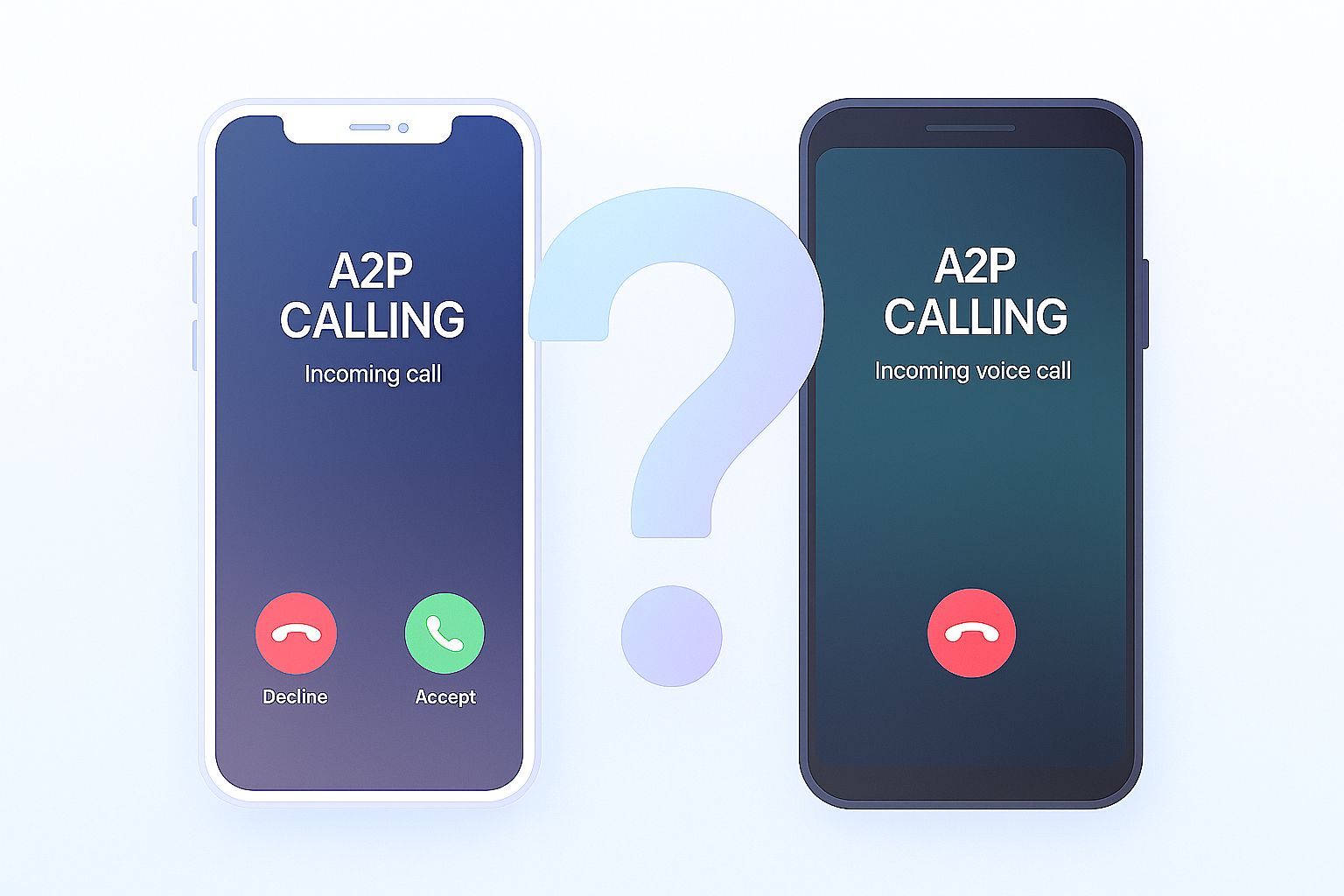If you've ever scratched your head at similar caller ID mysteries, you're not alone. Millions of smartphone users encounter A2P calling notifications daily, often without understanding what's happening behind the scenes. Let's demystify this technology that's quietly revolutionizing how businesses and services reach us.
What Exactly is Application to Person (A2P) Calling?
At its core, A2P calling is automated voice communication triggered by software applications rather than human beings. Think of it as the voice equivalent of those automated text messages you receive except instead of SMS, you're getting actual phone calls generated by computer systems.
When an app or service needs to reach you with time-sensitive information, it doesn't have a person pick up the phone and dial your number. Instead, it uses A2P calling technology to deliver pre-recorded messages or text-to-speech announcements directly to your phone. This could be anything from your doctor's office confirming tomorrow's appointment to your bank alerting you about suspicious account activity.
How A2P Calling Differs from Regular Phone Calls and Text Messages
Understanding A2P calling becomes clearer when you compare it to other communication methods you're already familiar with.
Person to Person (P2P) calls are traditional phone conversations between humans. When your friend calls to chat or your colleague rings about a project, that's P2P calling. These calls involve real time, two way conversation with natural pauses, interruptions, and the unpredictable flow of human speech.
A2P calls, by contrast, are typically one directional. The system delivers its message whether recorded or generated through text to speech and often doesn't expect or wait for a response. The volume is also dramatically different. While you might make a dozen P2P calls per day, A2P systems can generate thousands of calls per hour.
SMS alerts might seem similar to A2P calls, but they serve different purposes. Text messages work great for non urgent notifications you can read when convenient. A2P calls, however, demand immediate attention. They're perfect for time-sensitive alerts where you need to know something right now like a security breach requiring immediate action or a medication reminder that shouldn't be delayed.
The routing infrastructure also differs significantly. A2P calls often travel through specialized carrier networks optimized for bulk delivery, while P2P calls use traditional voice networks. This specialized routing is why carriers can identify and label A2P calls differently on your caller-ID.
The Technical Journey: What Happens When an App Dials Your Number
The process of A2P calling involves several sophisticated steps that happen in seconds, creating a seamless experience for the recipient.
When a healthcare app decides to send you an appointment reminder, it doesn't simply "dial" your number like a human would. Instead, it connects to an A2P calling platform through an Application Programming Interface (API). This platform acts as the bridge between the app and the telecommunications network.
The message content gets processed in one of two ways: either the app uploads a pre recorded audio file (like a professional voice actor saying "This is a reminder about your appointment"), or it sends text that gets converted into speech using text to speech technology. Modern TTS systems sound remarkably natural, though you can usually detect the slightly mechanical cadence if you listen carefully.
Once the audio is ready, the A2P platform hands off the call to carrier networks. These carriers have special agreements and technical infrastructure for handling bulk automated calls. The call gets routed through their systems, which stamp it with identifying information that helps your phone recognize it as A2P communication.
Finally, when the call reaches your device, your phone's operating system and carrier services work together to display appropriate caller-ID information. This might show the originating number, the business name, or labels like "A2P CALLING" to help you understand what type of call you're receiving.
Throughout this process, the A2P platform typically provides detailed analytics back to the originating app, including whether the call was answered, how long the recipient listened, and whether any actions were taken in response.

Real World A2P Calling: Examples You Encounter Every Day
A2P calling has become so integrated into our daily lives that we often don't realize how frequently we encounter it. Let's explore some common scenarios where this technology serves practical purposes.
Healthcare systems rely heavily on A2P calling for appointment reminders. Your dentist's office management software automatically generates calls 24 hours before your cleaning, reducing no shows by up to 40%. These calls often include options to press numbers for confirming, rescheduling, or canceling, though the initial delivery is automated.
Two-factor authentication has evolved beyond SMS codes. Many Android users now receive "flash calls" for verification the system calls your number, lets it ring once or twice, then hangs up. Your phone recognizes the calling number and automatically verifies your identity without you needing to answer or enter a code. It's faster than SMS and works even when data connectivity is poor.
Smart home integration creates some of the most surprising A2P calls. When you ask Alexa to "find my phone," it triggers an A2P call to your device. The system doesn't expect you to have a conversation with Alexa through the call it's simply using voice communication as a location tool. This explains why users sometimes see "A2P CALLING" from numbers they don't recognize, only to realize their smart speaker initiated the call.
Emergency weather alerts increasingly use A2P calling when SMS systems become overloaded during natural disasters. Hurricane warnings, tornado alerts, and evacuation notices can reach you through automated voice calls even when text messaging networks are congested.
Delivery and logistics companies use A2P calling for real time updates. When your Amazon package is out for delivery, an automated call might alert you about the estimated arrival time or provide instructions for package placement. These calls often include your order number or tracking information spoken aloud.
The Advantages: Why A2P Calling Works for Both Senders and Recipients
From a business perspective, A2P calling offers significant advantages over traditional communication methods. Voice calls have inherently higher attention-grabbing power than text messages. While SMS might sit unread for hours, a ringing phone demands immediate response. This results in engagement rates that can be 10 - 15 times higher than email marketing.
The accessibility factor cannot be overstated. A2P calling works for users regardless of their smartphone sophistication, data plan limitations, or visual impairments. An elderly patient who struggles with small text messages can easily understand a clear, spoken appointment reminder. Similarly, users in areas with poor data connectivity can still receive important voice alerts when SMS might fail.
For recipients, A2P calling provides immediate, actionable information. Instead of reading a text message that says "Your prescription is ready," you receive a call that can provide detailed pickup instructions, pharmacy hours, and even connect you directly to the pharmacy if you press a number.
The scalability is remarkable. A single A2P system can generate thousands of simultaneous calls during emergencies or peak business periods. This makes it invaluable for situations requiring mass communication like school closure notifications reaching every parent in a district within minutes.
The Dark Side: Why Carriers Flag A2P Calls as Potential Spam
Despite its legitimate uses, A2P calling has become a double edged sword due to widespread abuse by bad actors. Recent FCC crackdowns on robocalls and AI voice fraud have made carriers increasingly cautious about automated calling systems.
The statistics are sobering: Americans received over 50 billion robocalls in 2021, with many using A2P technology for fraudulent purposes. Scammers exploit A2P platforms to generate calls about fake car warranties, bogus IRS threats, and sophisticated phishing attempts. These bad actors have poisoned the well, making consumers suspicious of any automated call.
Carriers now implement STIR/SHAKEN protocols a caller ID authentication system that verifies the legitimacy of calling numbers. When A2P calls can't provide proper authentication, they get flagged as potential spam. This explains why your phone might display "A2P CALLING" or "SPAM LIKELY" even for legitimate business communications.
The situation is particularly complex because AI-generated voices have become incredibly sophisticated. Modern text-to-speech systems can mimic human speech patterns, emotional inflection, and even regional accents. While this technology enhances legitimate A2P calling experiences, it also enables more convincing fraud attempts.
International regulations vary significantly. India's TRAI (Telecom Regulatory Authority of India) has implemented strict consent requirements for A2P calling, while European GDPR rules add additional compliance layers. These regulatory differences mean that A2P calls crossing international boundaries face additional scrutiny and potential blocking.

Protecting Yourself: Security and Privacy Tips for A2P Calling
Understanding how to handle A2P calls safely requires a combination of technical knowledge and common sense. Here's how to protect yourself while still benefiting from legitimate automated communications.
Verify legitimate numbers by checking if A2P calls come from recognizable business numbers. Healthcare providers, banks, and established services typically use consistent calling numbers that you can find on their official websites or previous communications. If an A2P call claims to be from your bank but comes from an unfamiliar number, hang up and call your bank directly.
Understand your consent rights under the Telephone Consumer Protection Act (TCPA). Legitimate businesses must have your explicit consent before sending A2P calls for marketing purposes. However, transactional communications like appointment reminders for services you've already booked don't require separate consent. You can revoke consent at any time by following the opt-out instructions typically provided in these calls.
Use carrier-provided blocking tools effectively. Most major carriers offer spam detection services that can identify and block malicious A2P calls while allowing legitimate ones through. These systems learn from user reports and calling patterns to improve their accuracy over time.
Listen for authentication details in legitimate A2P calls. Real business communications often include specific information like your account number, recent transaction details, or appointment dates that scammers wouldn't have. Generic messages asking you to "call back immediately" or "verify your account" are red flags.
Never provide sensitive information during A2P calls. Legitimate automated systems won't ask for passwords, Social Security numbers, or banking details. They're designed to deliver information to you, not collect it. If an A2P call requests sensitive data, treat it as suspicious regardless of how authentic it sounds.
The Future of A2P Calling: Trends and Predictions
The A2P calling industry is experiencing explosive growth, with market projections suggesting it will reach $72 billion by 2027. This expansion is driven by several converging trends that are reshaping how businesses communicate with customers.
AI voice quality improvements are making A2P calls more natural and engaging. Modern systems can adjust speaking pace, add appropriate pauses, and even incorporate emotional tone based on message content. However, this same technology is prompting stricter verification requirements as regulators work to prevent sophisticated fraud.
Voice commerce integration represents perhaps the most significant future opportunity. A2P calls could evolve from simple notifications to interactive shopping experiences, allowing customers to make purchases, schedule services, or modify orders through voice commands during automated calls.

Key Takeaways: Understanding A2P Calling in Context
A2P calling represents a fundamental shift in how automated systems communicate with humans, moving beyond text-based notifications to immediate, attention-grabbing voice communications. When implemented responsibly with proper consent and security measures, it serves legitimate business and safety purposes that benefit both organizations and consumers.
The technology's reputation suffers from widespread abuse by fraudsters, but understanding how to identify and respond to legitimate A2P calls helps you take advantage of its benefits while protecting yourself from scams. As carriers implement better authentication systems and regulations become more sophisticated, the distinction between helpful automation and harmful spam should become clearer.
The future of A2P calling lies in balancing technological capabilities with user control and security, creating communication systems that are both efficient and trustworthy.
Want A2P that actually connects? See SuperU live: book a demo
Frequently Asked Questions
1. What does A2P calling spam mean and how do I stop it?
A2P calling spam refers to automated calls that use Application-to-Person technology for fraudulent or unwanted marketing purposes. To stop them, enable your carrier's spam protection services, report suspicious numbers to your carrier, and never provide personal information during unsolicited A2P calls. You can also register with the National Do Not Call Registry, though this primarily affects marketing calls rather than scam attempts.
2. Why does my iPhone label some missed calls as A2P?
Your iPhone labels calls as A2P when your carrier identifies them as automated, application-generated communications rather than human-initiated calls. This labeling helps you understand the nature of the call and make informed decisions about whether to return the call or treat it as potentially suspicious. The label appears regardless of whether the A2P call is legitimate or spam.
3. Are A2P voicemail drops legal in Texas and New York?
A2P voicemail drops are legal in Texas and New York for transactional purposes (like appointment reminders) and when recipients have provided consent. However, marketing-focused voicemail drops must comply with TCPA regulations, including consent requirements and opt-out mechanisms. State laws may add additional restrictions, so businesses typically work with legal counsel to ensure compliance.
4. Is there an A2P calling app I can use for personal reminders?
Several apps offer personal A2P calling features, including appointment reminder services, medication alert systems, and custom notification platforms. Popular options include services like CallFire, Voice123, and some features within comprehensive communication platforms. However, these typically require subscription fees and may have usage limitations for personal accounts.
5. Can Alexa trigger an A2P call on its own?
Alexa can trigger A2P calls when you request specific actions like "find my phone" or when configured to send alerts through connected services. However, Alexa doesn't initiate A2P calls independently it only responds to your voice commands or pre-programmed routines you've set up. If you're receiving unexpected A2P calls supposedly from Alexa, verify your device settings and consider if someone else in your household might have triggered the calls.
Start for Free – Create Your First Voice Agent in Minutes


